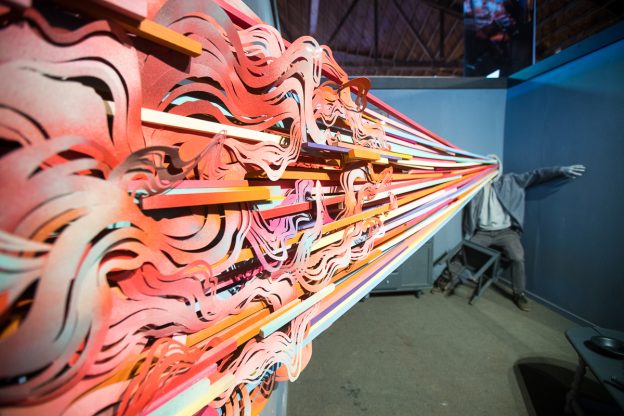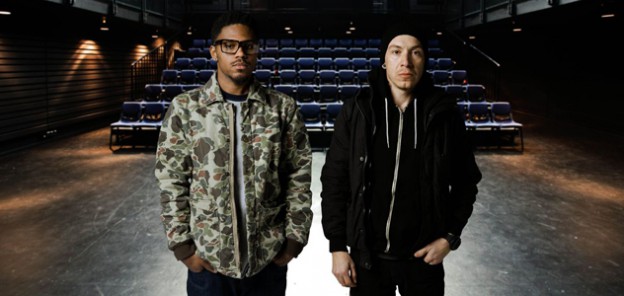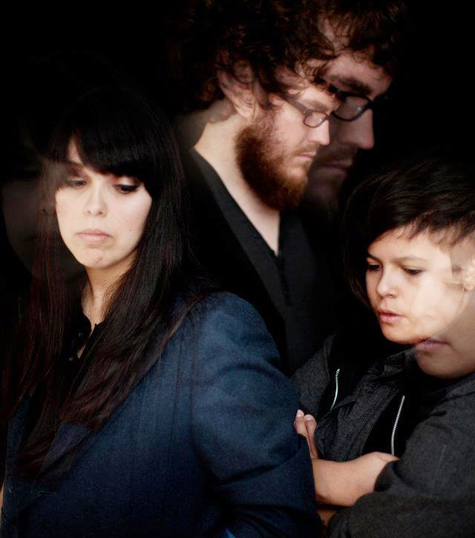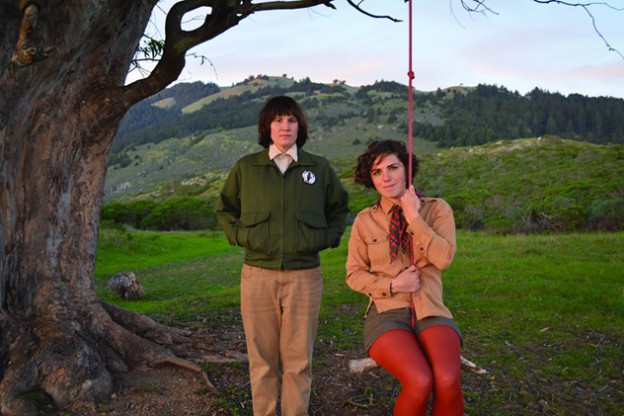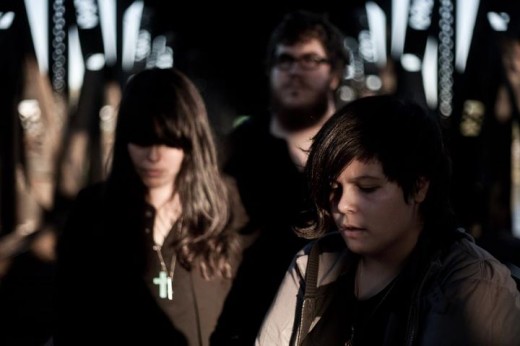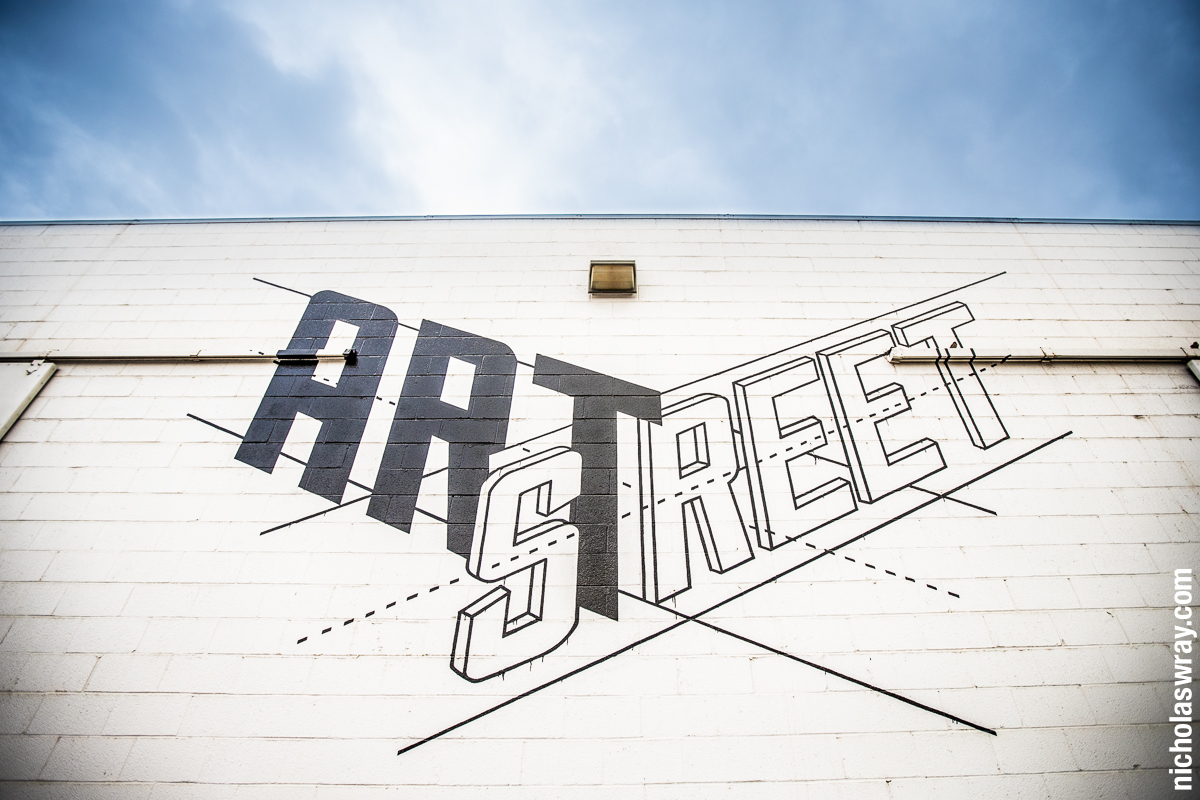
I felt like a child again.
In wonderment, in awe, jaw agape, I excitedly weaved all over ArtStreet, unable to believe my eyes. Or any of my senses. The overwhelming magnitude of this project is made even more special by its impermanence. Its world-class contribution to arts and culture is trumped only by the pride-inducing fact that our neighbors made this happen, right in our own backyard.
Organized by M5 Arts, a collaborative holacracy that was responsible for last year’s tremendously successful and acclaimed Art Hotel, gathered more than 100 artists together in a 65,000 square-foot warehouse to create an arts experience that dazzles. Beyond visual art, daily events include live music, poetry, dance, history lectures and more. Made possible by the contributions of the city and a number of businesses and individual patrons, ArtStreet opened its doors on Feb. 3, and will say its goodbyes on Feb. 25. Your inner child will thank you for visiting.
While actual children were taking it in on my many visits, there are some exhibits that warn prior to entry that they are not kid-friendly, and in fact, may trigger victims of abuse and rape. Art should make you feel, and tears streamed down my face as I read the stories of rape and molestation victims, juxtaposed with their anonymous nude photos in one exhibit. In another, entitled This is What It Feels Like, you enter through a curtain into a dark room. Violent sounds of breaking glass fill the room as you fumble in the dark for headphones hanging on the wall. Listening to men catcall and say things like, “Suck it, babe,” and “Smile,” is meant to invoke the fear, anger and degradation that too-often accompanies girlhood and womanhood.
We spoke to some of the artists who participated in the creation of ArtStreet to get some insight about their work. Here are explanations of their contributions, in their own words.
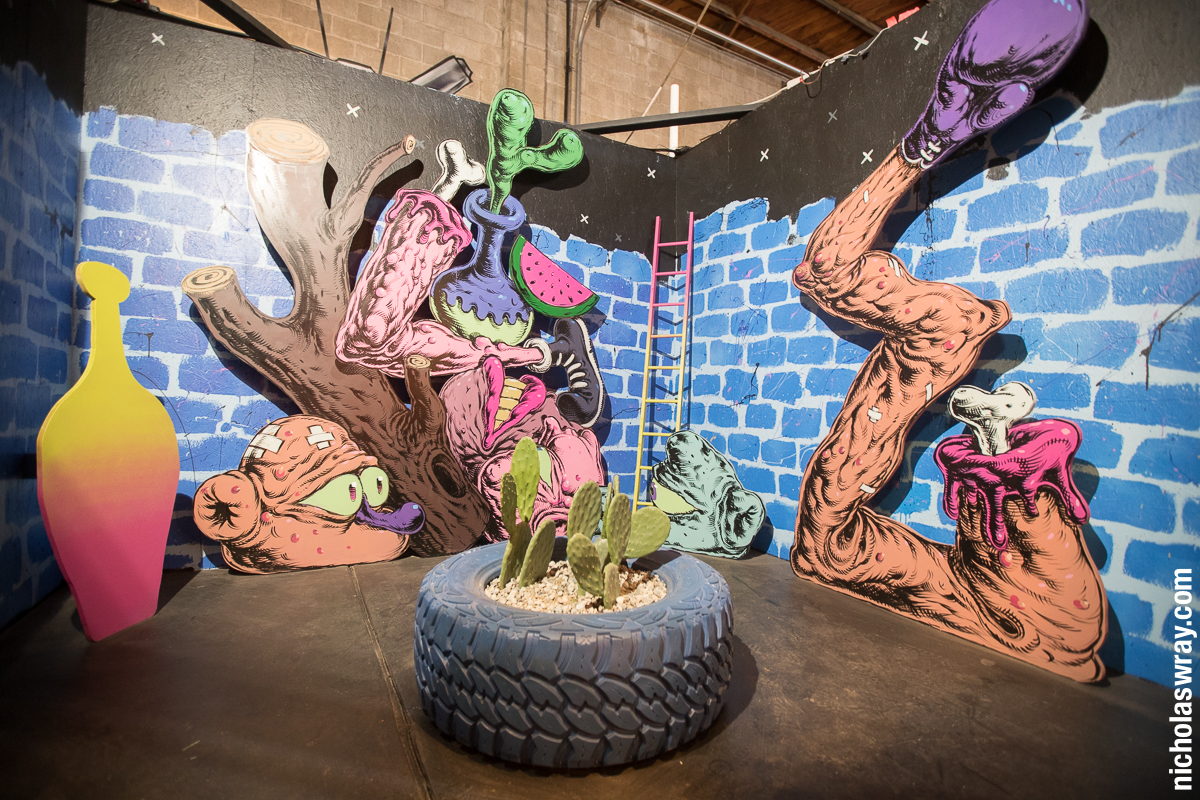
Photo by Nicholas Wray
Jared Tharp
“When I make art, I like to remain somewhat vague with my narrative. Even as I go, I prefer to let it all unfold during the process. I guess the reason behind working in this way is so that I can also step back as a viewer and attempt to decipher what I’ve done. For this project I felt that there were a few ideas woven together. However, I had a lot of fun playing with the idea that human beings and other objects in nature are essentially made up of the same stuff. In a painting, a tree can be an arm. A head can be a rock. For me, these are fun things to think about. I cut large shapes out of wood and mounted them to the walls, then I painted on them. The centerpiece was a tire that I found in front of my neighbor’s house. I was drawn to it, so I scooped it up and turned it into a planter for some cacti. The whole thing took me about a month to complete. In the process, I think we all grew closer as a Sacramento art fam, too. It was grueling work, but it definitely paid off.”
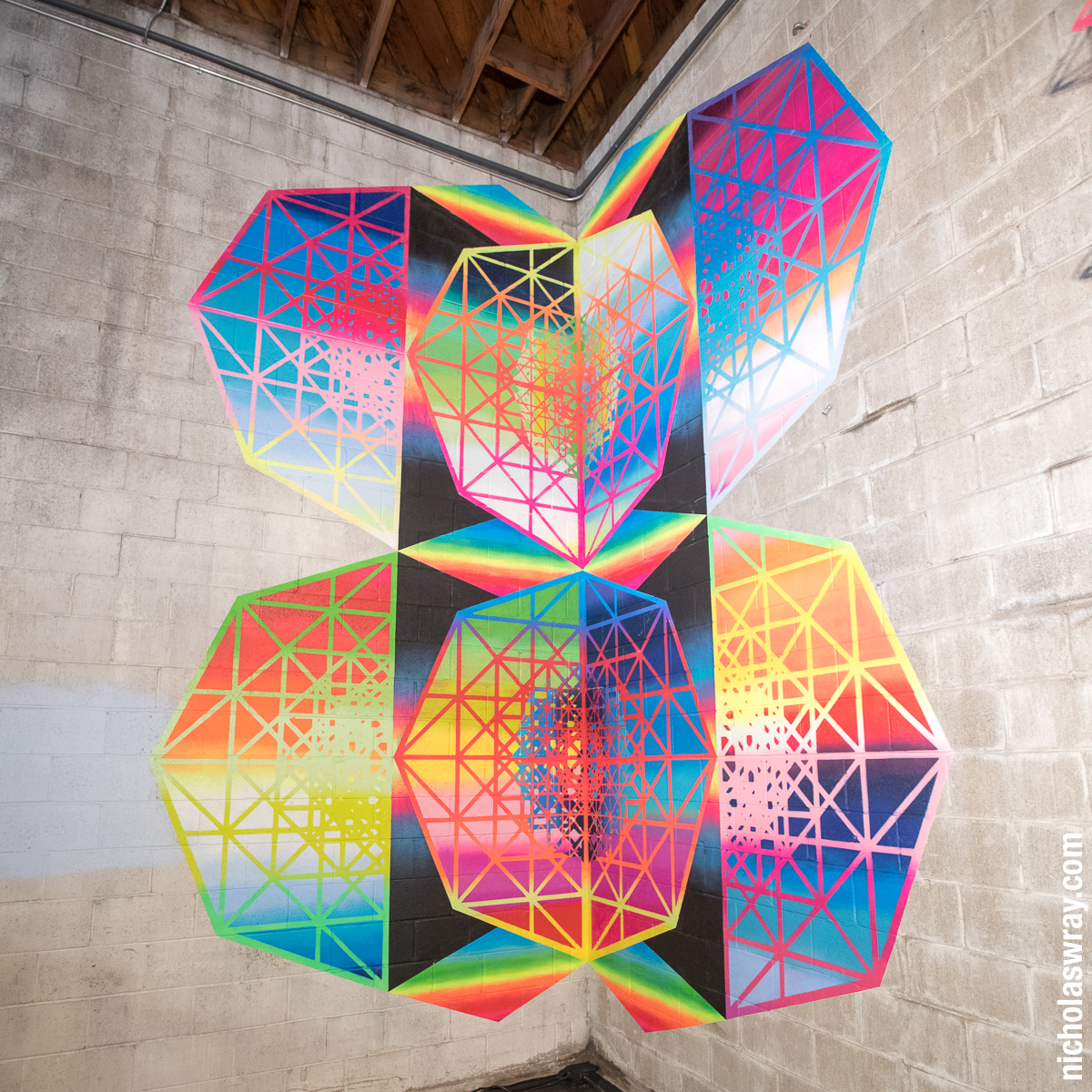
Photo by Nicholas Wray
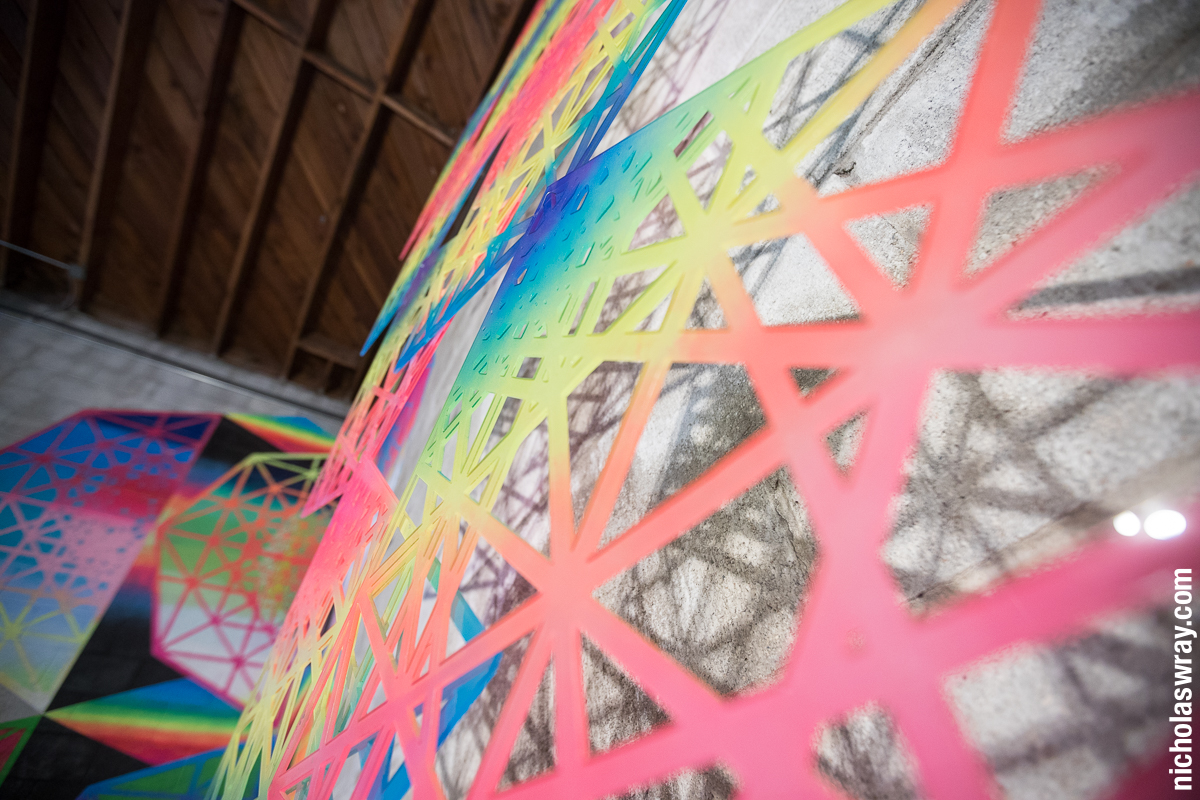
Photo by Nicholas Wray
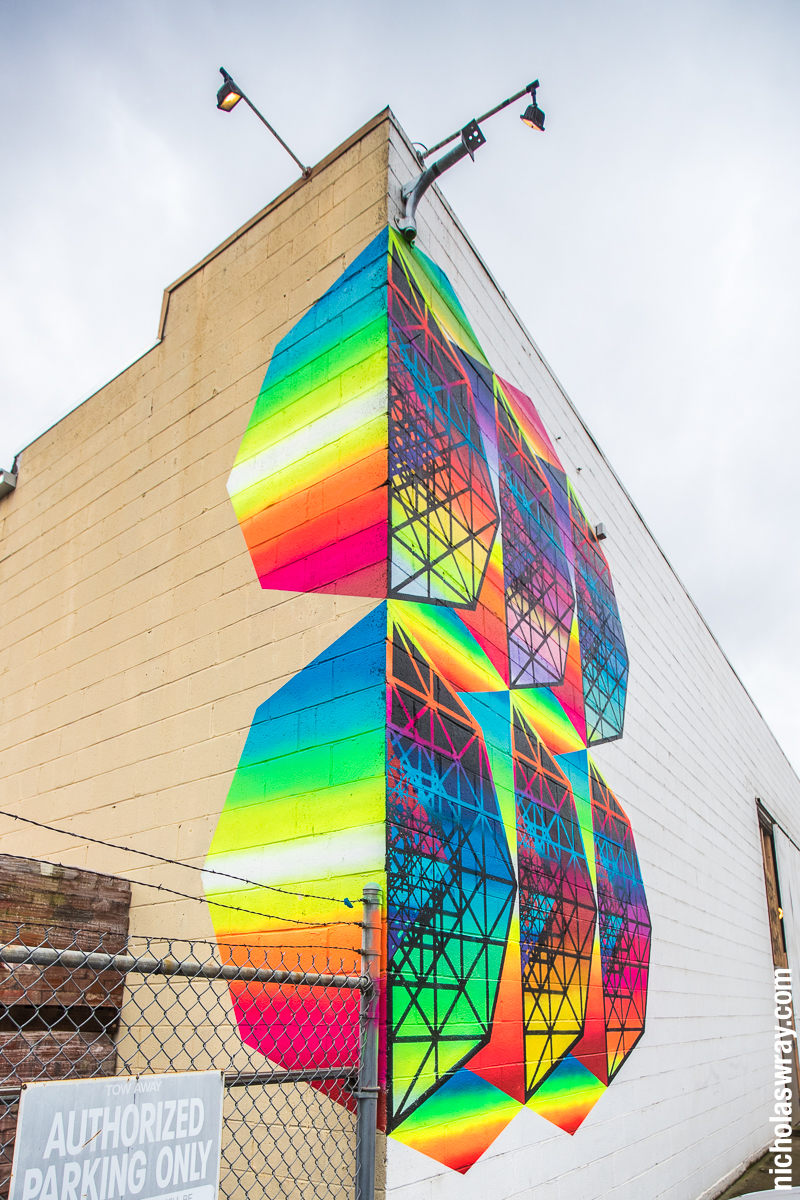
Photo by Nicholas Wray
Jose di Gregorio
“The initial idea behind my work was for the exterior and interior mural to be identical, so that it was a window or portal of sorts. The layout shifted a little and ultimately, I felt that having the work in the same Northeast corner without necessarily being mirrored would be perhaps more effective. The exterior wall might just be a peripheral piece as you walk in, but the familiarity of the design on the inside wall would have the viewer reconsider what they saw outside. The laser-cut pieces are of the same pattern aesthetic, but in 3-D form. Working with M5 is like working with any of my other weirdo peers. I love it. We all thrive on the pressure to create some sort of alchemy magic with whatever resources we have. I want weirdos to be a larger fabric of all society. Especially now. You all need us more than we need you.”
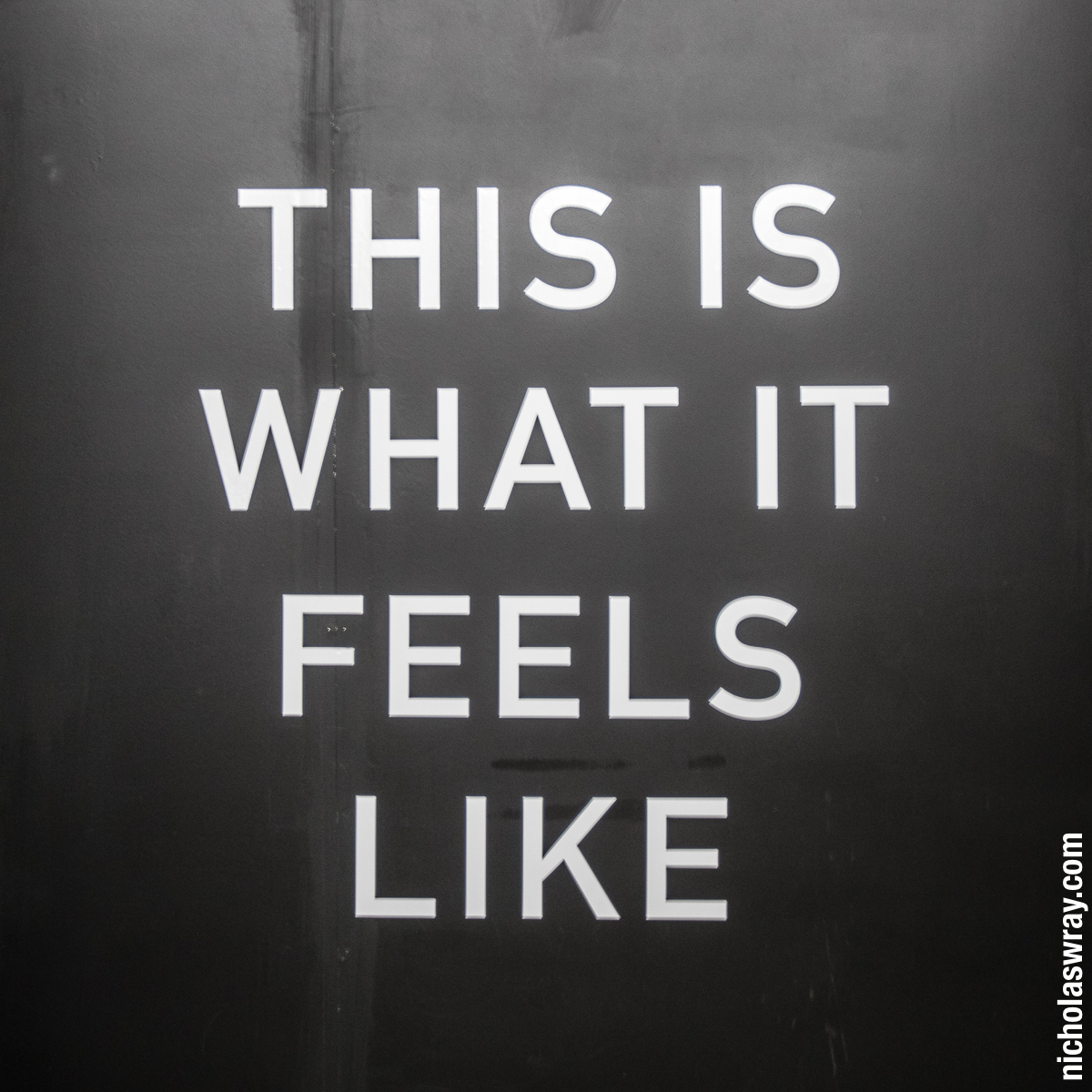
Photo by Nicholas Wray
Terra Lopez
“This Is What It Feels Like is intended to help shift our culture’s patriarchal views on how society treats women, and help create and sustain a discourse on the ways that we can simply be better to and for women. This auditory exhibit is intended to be an educational tool to help spark a dialogue amongst men of all ages as to how they can help create and be the change that our society needs in order to stop misogynistic patterns that have become embedded into our culture. There is a mirror directly in front of the patron where they are then able to self-reflect as they continue to listen to the hundreds of catcalls that were directly taken verbatim from women.”
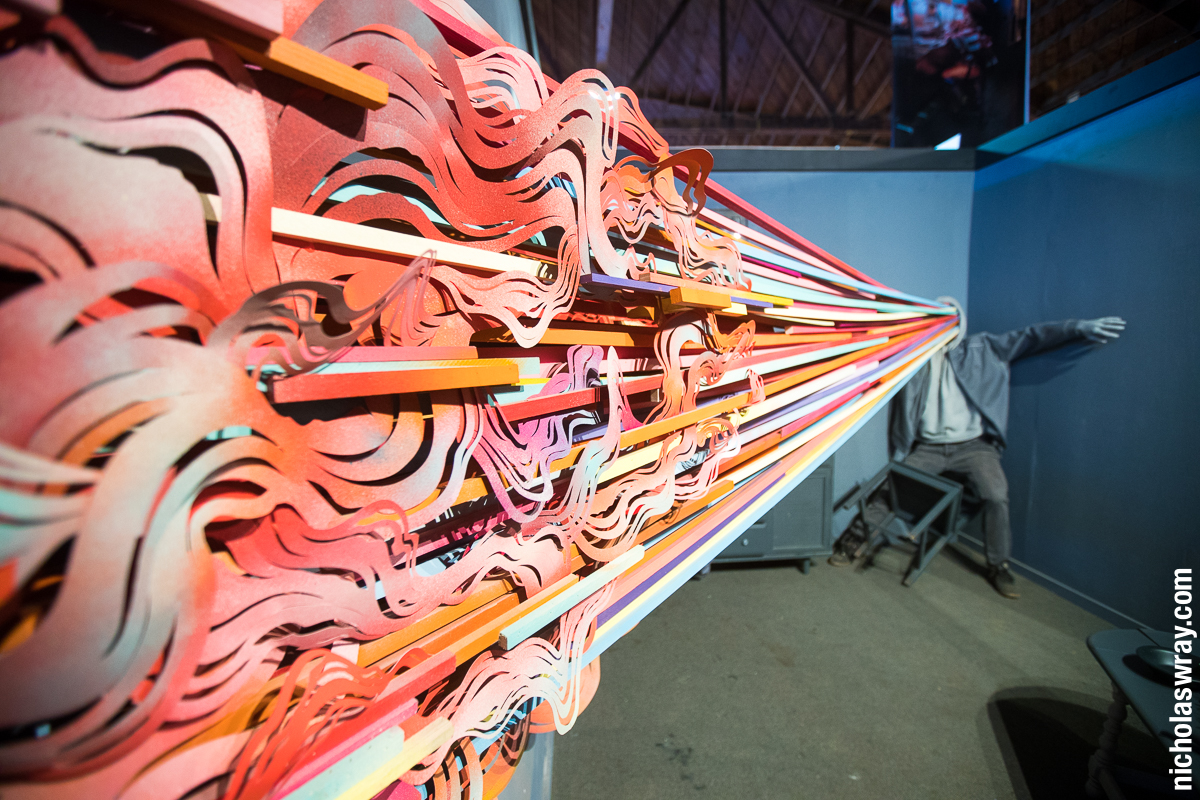
Photo by Nicholas Wray
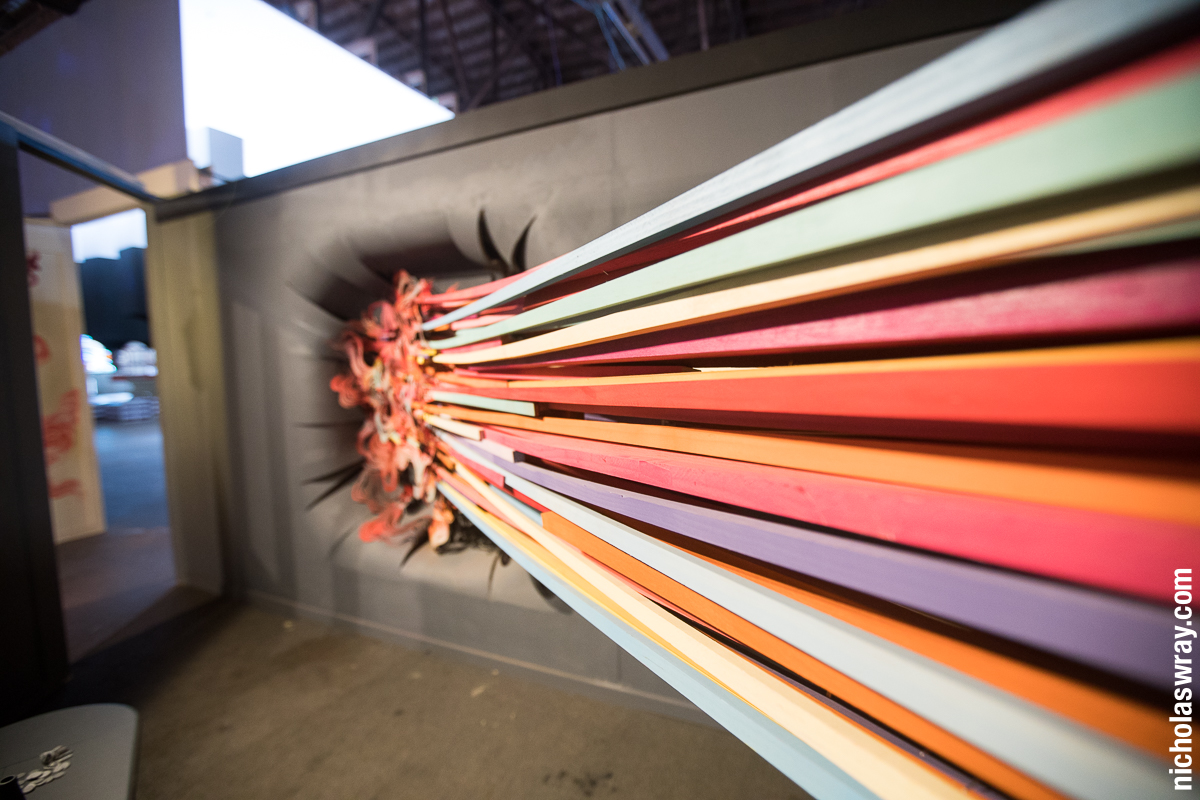
Photo by Nicholas Wray
Franceska Gamez
“I’ve been working with our site team on ArtStreet for about two months. Shaun Burner and I were going back and forth trying to decide whether or not we would even a have a room, because we didn’t think we would have the time or frankly, the space, but once we got our ideas rolling, we couldn’t turn back. Shaun and I began our room as soon as we got the walls up. We were definitely riffing off of the concept we had at Art Hotel, with the wooden man, mid-travel, a moment in time where you see him stuck between two worlds. The concept evolved more and more everyday after we dealt with logistical issues, building, meetings, etc.; we took time to sit in front of our room and dream away. We wanted to create a stale room, a monochromatic representation of everyday life in a box, a place you would call home, to contrast and highlight this magical explosion of color. Whatever this entity means to you, the color in your life, it is something to behold and really take the time to appreciate, and exercise if needed.”
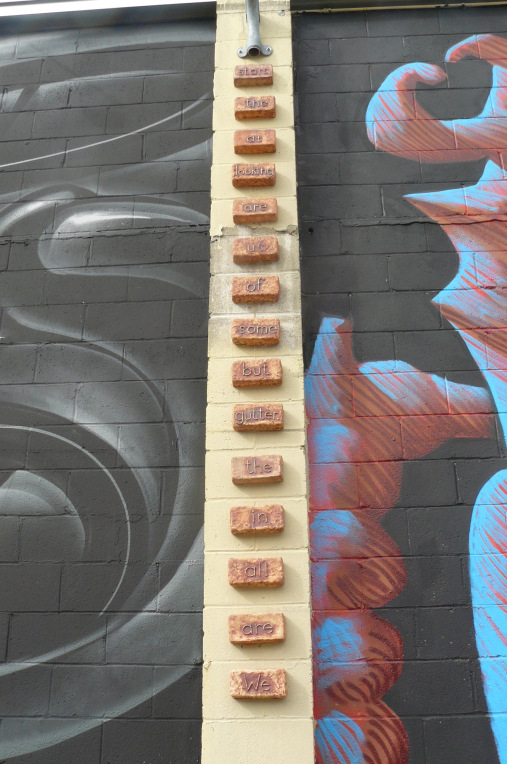
Photo by Aaron Cheesman
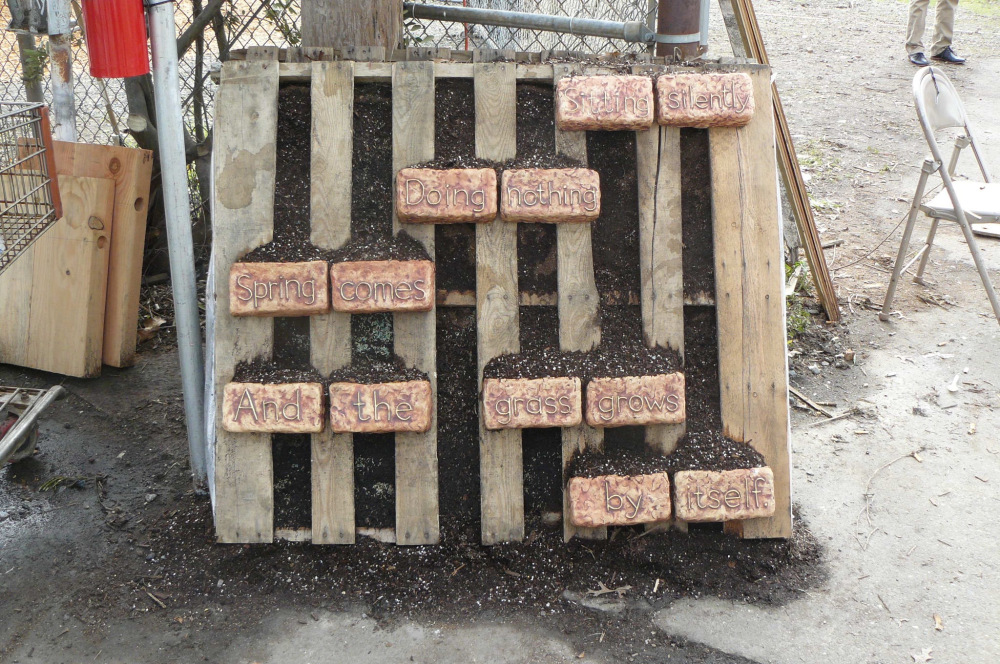
Photo by Aaron Cheesman
Ianna Frisby
“I began with an ordinary object: the brick. No other object better represents the sweeping societal changes that came with factory production, industrial revolution and the wealth that it brought. The brick literally became the building block of a new society—one that permitted the emergence not only of privileged idlers but also a commercial pageant for them to take in, one nonchalant step at a time. Compared to the more traditional agrarian landscape, this spectacle must have seemed a fantastic novelty. I repurposed the brick and transformed it from a banal structural element into a mode of expression that harkens the romance of the Gilded Age. I begin by forming wet clay around an actual brick. After the clay hardens, the brick was carefully removed leaving a hollow form, a brick negative, onto which words were hand-sculpted and gilded with luster. Just as structural bricks form a supporting wall, these messaging bricks are arrayed in such a way as to train the eye and form thoughts as the flâneur walks by and considers their place in that world at that moment. These brick negatives are lightweight and adhered to their backgrounds. The idea is that, rather than call attention to themselves, the bricks quietly reveal themselves only when passersby pause and look more closely. The messages presented by the bricks come from a collection of musings by celebrated flâneur artists and thinkers.”
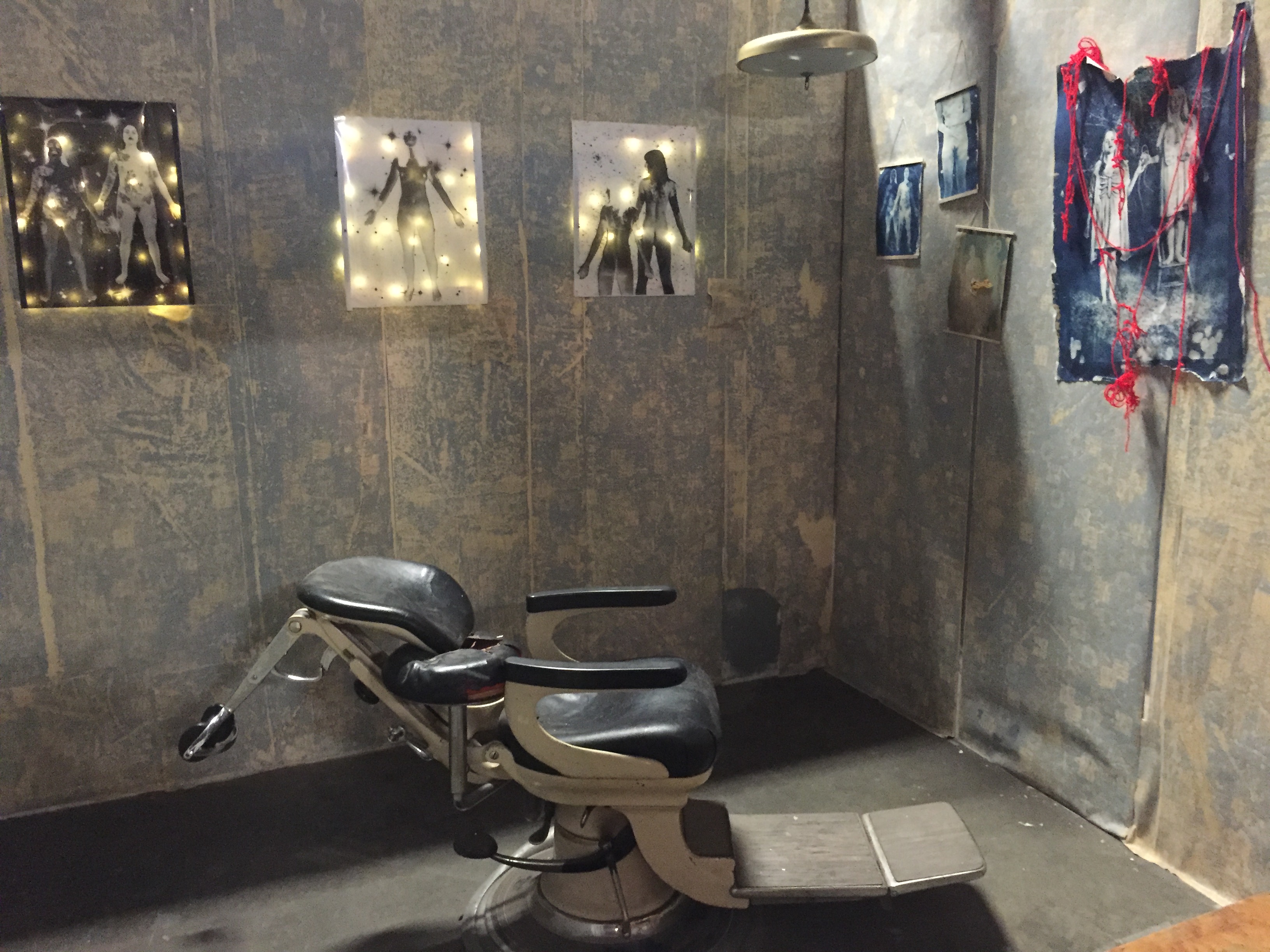
Photo by Niki Kangas

Photo by Niki Kangas
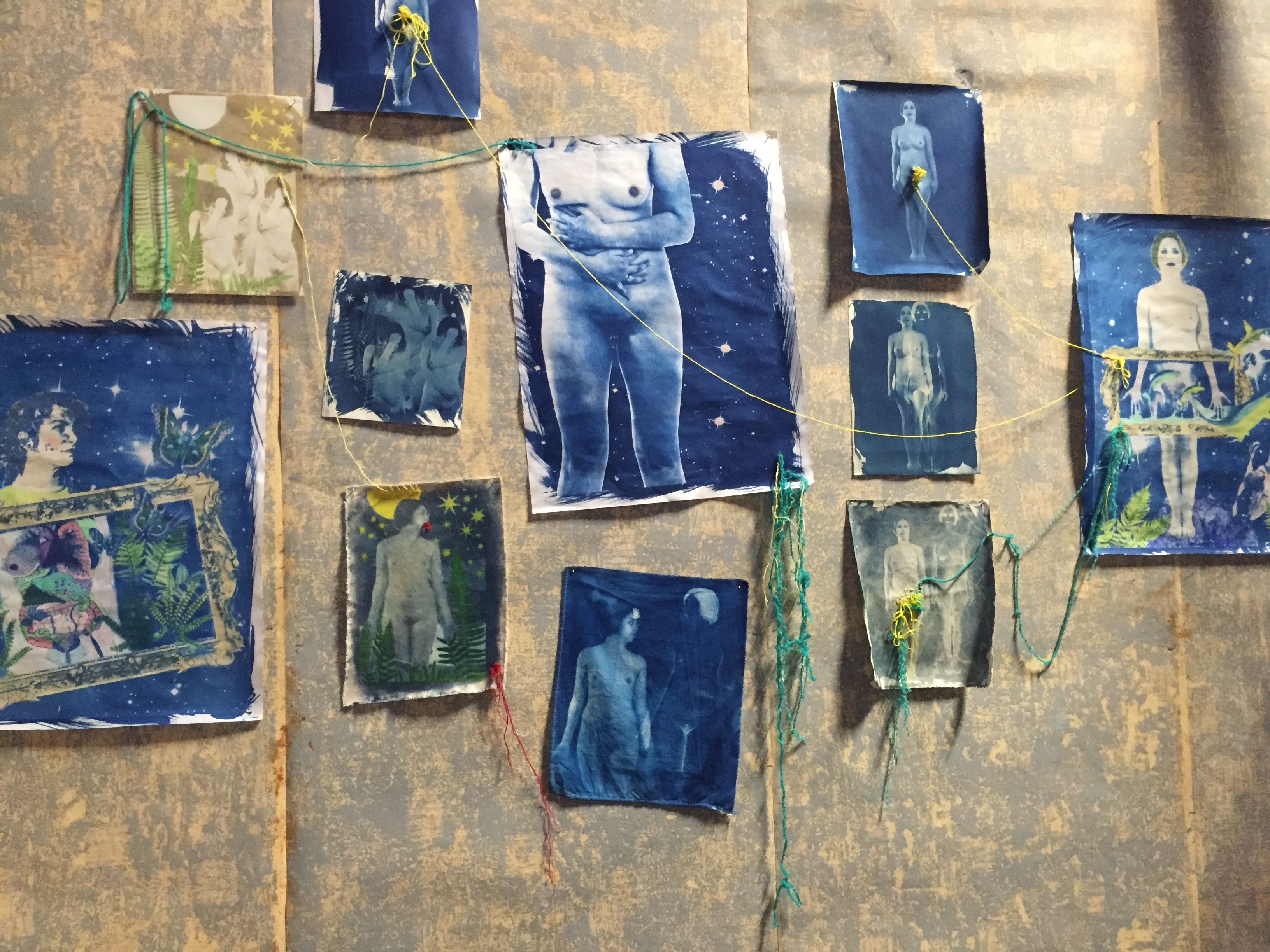
Photo by Niki Kangas
Melissa Uroff Millner
“The Room of Mistakes is full of work that I’ve ‘messed up’ on; however, when it is all put together it comes together quite nicely. Trying to build my ArtStreet project, I was very, very pregnant, and things just kept going wrong. My kiddo came super late past her due date, which cut my creation time in half because while pregnant you cannot use photo chemicals. I was running out of time, the prints I created were not working out, screws fell out of the walls, negatives came late, everything that could go wrong did, so I ran with it. I ‘tied’ everything together with actual string and it turned out more powerful than I had imagined. I captured perfectly what it is like being a very new mom and a full-time artist; chaotic, messy, delirious, dreamy and still kind of fun.”
KiCo (Kitchen Collaborative)
Food is art, too. And chefs, artists. So in keeping with the spirit of ArtStreet, local chefs from all over Sacramento are volunteering their time and collaborating to offer different culinary delights each day at ArtStreet. Word to the wise: bring cash, so you can enjoy beer and wine served throughout the venue, make donations to the project and buy some awesome, inspired grub.

Photo courtesy of M5Arts
Some participating chefs include Ed Roehr of Magpie Cafe, Bryan Widener of Revolution Wines, Scott Ostrander of Park Winters and Ben Roberts of Pizza Supreme Being. Says Roehr, “The idea was to create a space where local cooks could collaborate and support the arts, and explore working together in a culinary environment. KiCo is an opportunity for cooks to work on a common project, without the competitive stress of vending and without the big corporate sponsorship some festivals bring with them.”
For more information, reservations or to purchase special event tickets, visit M5Arts.com. ArtStreet is located at 300 First Ave. in Sacramento, is free to the public and is open now through Feb. 25, Monday–Friday, 3–9 p.m. or later, and Saturday–Sunday 11 a.m.–9 p.m. or later.
****** CLICK HERE TO SEE MORE PHOTOS FROM ARTSTREET ******
Devoutly Dynamic
TBD Festival, West Sacramento, Oct. 4, 2014: Even though the sun went down hours ago, warm dust still erupts into the air like the billion microscopic remnants of an obliterated world. My mind is already reeling from the gauntlet of great acts I’ve been shuttling back and forth to glimpse from one patch of riverfront land to the next; brilliant, virtuosic performances seem to flare out on all sides from different vistas, pushing the inter-stage wanderer towards a kind of polyphonic high. The sound, the flashes of light, the smell of incredible food and the miasmatic, billowing dust after a full day of sun have started to take their toll.
Determined yet tired, I trek towards the far side of the concert area, into the volume and light, to secure bodyspace for the concluding main stage performance of the evening. But somewhere around the halfway point, I pause, struck by a bluish ethereal glow and the thrum of brooding synth and bass accompanied by emotive, full-bodied vocals. I am caught off guard; the sound beckons, the conflicted groove is perfectly in sync with my mental state; it zeroes in on me with an intensity that isolates instead of pummeling the senses. I gaze up at the stage, and enter the realm of Sister Crayon.
Shine Coffee, Sacramento, July 11 2015: I’m sitting across from Terra Lopez and Dani Fernandez, the creative force known collectively as Sister Crayon. The two are remarkably down-to-earth and open, a fact which their otherworldly, often mercurial music belies. Never before has their sound been honed so sharp as on their newest release, Devoted, released early last month. Pared down from a four-piece to their current duo, the project has plunged ahead with the carefully crafted sonic workings of Fernandez and the intensely personal lyrical performances of Lopez. Both are keen to show the specific sources from which their creative output arises, whether it be turbulent personal relationships or a diverse array of contemporary artists and budding music genres. The night before our meeting, the two even showcased some of their favorite material at Dive Bar as a DJ set, and are gearing up for a live show at Harlow’s in early August—their first locally since the release of Devoted.
Our caffeine-fueled discussion, recorded here, skirts topics ranging from spirituality, love and hate and the risks of creativity. Enjoy!
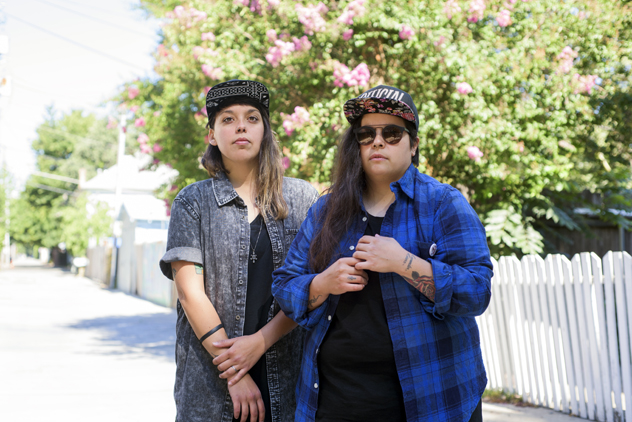
How did the DJ set last night go? What sort of material did you select?
Terra Lopez: Last night was a lot of fun. Good crowd, good energy. It’s always fun coming back to our hometown. We just like to play songs that we like really loud [laughs]. For our set we selected a lot of footwork, a lot of juke stuff from Chicago, deep house, a lot of drum/bass-heavy stuff that’s really influenced our sound and resonated with us. A lot of beat-driven songs, a lot of bassline.
How was the process in crafting the production on Devoted?
Dani Fernandez: We wanted to focus more on a beat-heavy sound and showcase the vocals, and we’ve never really done that on our last albums. There were so many other things going on before, and we wanted to strip that away.
TL: We wanted to make a sound that was undeniable, with how I was feeling lyrically, we wanted that to take precedence along with the beats, and not have anything crowd it—almost a minimalist approach the whole time.
What was the first creative step taken with that album?
TL: We demoed a lot in Sacramento and in Oakland, [Fernandez] lived here at the time. And we would just send each other ideas back and forth. For the first time, we got on a plane with 20 unfinished tracks—we had never gone into a studio with unfinished ideas, so it was really scary. We both didn’t know what to expect.
DF: This was the first time we had done a record on our own.
TL: Yeah, it was nerve-wracking. We got to Florida to work with our producer Wes Jones in St. Augustine and we spent two weeks there in this tiny little town. We didn’t know anyone except for Wes, and we slept and lived at the studio for two weeks—it was a very isolating experience. We were basically in our heads for two straight weeks, and it drove us a little crazy … But it was awesome. It was incredible to be so isolated, it felt like an alternate world that we were in.
DF: Almost all of it just spilled out in those two weeks, very easily. There was never really any arguing.
TL: It was pretty much a dream to be able to work that way. To have that freedom. And then literally on the last day, on our way to the airport, Omar Rodriguez-Lopez [of The Mars Volta] wrote me and asked if he could help produce the record.
I understand Omar had been a fan of your project before he stepped up to produce?
TL: We were lucky enough to go on tour with one of his projects in 2013, and we toured with them extensively and from that tour, we built a friendship with him and his band and so they really liked what we were doing, they would watch us every night, and hang out with us. You know, he’s a pretty reclusive guy, so the fact that he even wanted anything to do with us was a big deal.
DF: We knew that he liked us when he invited us to the movies one night on tour. He doesn’t do that regularly. He likes to stay to himself on tour, not really be on the scene with everybody, but he was totally talkative, wanted to get to know us, loved what we were doing, loved the sound. And you could tell that he was really curious as to what we were setting out to do. It was really cool.
So overall, it was a pretty tension-free recording process?
TL: Yeah, we were very grateful to have had the team that we had, because it was such an organic process. We would spend eight-nine hours working with Wes on the songs, and if we needed a break, we’d go jump in the ocean, and then come back and work until two, three or four in the morning, and then start over the next day—and it was like that for two weeks.
DF: Now I get why artists tend to record in secluded areas. They’re always holed up near a beach, or at a cabin in the woods somewhere. It makes you really focus and hone in on your music. It’s probably going to be the way we record from now on.
I understand you featured “Ride or Die” as a video to coincide with the recent SCOTUS decision?
TL: We did. We had actually shot it a week prior, and it wasn’t a planned thing. I had woken up that morning and seen the Supreme Court’s ruling and was so inspired. So I reached out to the director and was like, “If there is any way that we could release that video today, it would be so fitting.” The song is a celebration of love; the video definitely is. We really just wanted to celebrate the day. Dani and I had never really put ourselves out there with our orientation; it’s a known thing among people who ask us, we’re very open, but we had never really put it out there in a video. Everyone was on board, so we just released it. It was a beautiful day, just a gorgeous day, a really proud moment. To release something in correlation with it meant a lot to us. We were finally able to put the message of our music forward in our own subtle way.
Along with these feelings of a triumph of love over hate, there’s also been a good deal of ambivalence towards the concept of love in your work …
TL: It’s incredible that you picked up on that, because I’ve done a few interviews where that kind of goes over their heads. For me, I was in a place when I wrote that, when I was starting to write the lyrics for these songs, I was heartbroken. I’d been in a five-year relationship, had my heart broken, and I’d never experienced a loss like that before. A loss of love, but also a loss of self-motivation—it was the first time it had ever happened to me, and I really clung to this record with Dani, in order to get out of bed most days back then. So for me, I wasn’t singing about that love loss, necessarily, I just didn’t believe in love at all. During those months when we were writing, I really didn’t, and I was questioning it, dissecting it. I had always believed in love, and I’ve always wanted to, but I was definitely in a place where I was trying to figure out if I still did. And so the whole album was basically a way—we called it Devoted because it was our way of practicing devotion as a way to restore our faith in it. And so there’s definitely moments, it’s kind of like a roller coaster where I’m clinging to that belief that it’s still there, even though I don’t feel it.
It seems like many of your releases have been influenced by particular relationships?
TL: I think that with Bellow and Cynic I was very vague in my language. Especially on Bellow … we were so young and didn’t think anyone would even hear that album, so we made it for ourselves. As a songwriter, I was very, very vague. I would speak about people in metaphors—you would never know what the hell I was singing about. And Cynic was very much straightforwardly about my mother and my father and my childhood, but I still was a little vague about expressing myself. When the time came for Devoted, there was no way around it. I didn’t have the time or the energy to make metaphors, I had to express exactly what I felt.
Do you think it’s necessary to suffer for art?
TL: I’ve never been able to write when I’m happy, and I admire those who can, but I’ve never been able to. I don’t necessarily need to be in a dark place, but I do need to contemplate. I dwell a lot.
What’s next for Sister Crayon? What should we expect at Harlows on Aug. 1, 2015?
TL: We’re working on two videos and some remixes; a lot of content coming out in the summer and in the fall. As for Harlow’s, expect a brand new set of songs that we’ve never played here. Just an entirely new experience, new merchandise and new feelings We’re coming out with a completely different kind of performance.
Give Dani and Terra a warm welcome home to Sacramento! Sister Crayon will play Harlow’s on Aug. 1 with DLRN and Stevie Nader. Doors open at 9:30 p.m. Tickets for this 21-and-over show can be purchased in advance for $12 at Harlows.com.
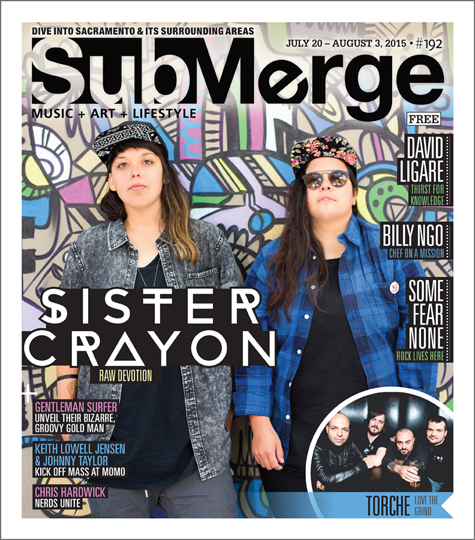
15 Years, 11 Tracks, 11 Vocalists, 2 Bandmates: Tel Cairo
Words by Joe Atkins
For the last 15 years Cameron Others and 7evin have been working on their material, laying out beats, loops, archaic recordings of bedroom beatbox compilations and reworking that material into new orchestrations. In the last two years it’s all come together, and now, as Tel Cairo, Cameron and 7evin are set to release their debut full length, Voice of Reason. The album itself has been part of the long process of self-discovery for these two electronic musicians. Their sound, their relationship to composition, their knowledge of technique and technology have increased with each singular endeavor, and the result is a precision track listing of rattling low-end bass and twinkling high-end melodies.
And I’ve yet to mention what, for me, is the most impressive part of the album: its list of local MCs and vocalists who dominate the lyric and lead portions on the majority of the project. It’s a list of past, present and future Sacramento stars, artists whom have been working the scene for the last two decades trying to lift the city up with their own talents and careers. There are individual appearances from Aurora Love, “This Is Not”; Agustus thElephant, “Music Box”; and Mic Jordan, “Electro Knock.” On “Twelve Paths Toward Movement,” Sister Crayon frontwoman, Terra Lopez appears alongside hip-hop local TAIS; Mahtie Bush spits verse after verse on the track “Illicit” and the unknown, yet powerful, Stephanie Barber holds down the hook. Lest we find ourselves stuck in the lady sings the hook cliché, Paper Pistols new lead, Juliana Lydell sings the verses to the high pitched chorus of Caleb Heinze, from Ape Machine and Confederate Whiskey; and Task1ne, Voltron reference and all, flows over the verses of “Evening Push,” before local legend Jonah Matranga gives his signature falsetto to the hook. It’s a list that’s both diverse and impressive, and it makes for an album that highlights the many dynamic qualities of music in Sacramento.
Breaking from some highly competitive Wii, 7evin and Cameron sat down with Submerge, and we talked about Sacramento, influences, genre, processes of songwriting and recording, skateboarding, musicianship, Ira Skinner’s beard and the talented slew of lyricists they worked with on the album. In addition, Submerge exchanged a few emails with the lyricists, and, likewise, we share their thoughts on working with Tel Cairo.
What brought you to Sacramento? What are the best and worst parts about this city?
7evin: I moved here about eight years ago to work with Ira Skinner, a good longtime friend. Sacramento has an amazing group of musically talented individuals. We like what’s going on here. The cost of living is amazing; you don’t have to feel so pressured. The bad part is that there is almost no monetary value for art here.
Can you describe your songwriting process?
7evin: A lot of times we start off with analog, a guitar, drumset, bass. We get in there and start doing electronics. We don’t do samples. We do our own tones and MIDI controlling. There’s always one part, and we shoot it to the next person until he can’t work on it anymore, and he shoots it back. We’ll meet once a week and we’ll work on that song. We made 32 tracks for this album and 11 made the cut.
What sort of influence did Ira Skinner have, working with him as a producer?
Cameron: Ira let us figure out who we were. He took all the things we’d been layering for so long, and we’d forgotten what we started out with, and made them sound amazing. Some of these things were already done. We’d put so much into it. We needed to step away a little bit.
7evin: He is so chill in the studio. He let us fumble around to find a niche, and the second he hears something that’s good, he’s like “Wait, go back! Let’s do that.” We have the first word, bounce it off to someone in collaboration; we get the second word, and Ira comes in; and we get the final word.
Cameron: In between there was also a lot of growth and learning on our side, with the programs.
Of the two of you, who’s the biggest perfectionist?
7evin: We’re never happy with it.
Art is never done. We just move onto another song.
Cameron: We look at things a little differently. I’ll hear things differently that he might not hear. Technically, I think he’s the perfectionist, making sure everything is lined up. I’ve tried to watch, and I’ll fall asleep for a little bit.
7evin: We tag team it, recording. I’m 20 percent deaf in my left ear. I don’t hear high end, I hear mid-tone and bass. You can see that and feel that live. [Cameron will] come in and stick this melody here. He brings the beauty to my dirtiness. I’m a gutter-punk; this guy comes in, and he’s playing 12-string guitar. We’re very similar but we’re like the Alice in Wonderland, Looking Glass Mirror versions of each other.
Cameron: We get inspired at the same time from different things. We get a feeling. It could be DJ Shadow, it could be anything, a country song; our creative juices start, and we just sit down and see what comes out. When we work together we balance each other’s ideas.
I know that every collaborator brings a different set of skills to the studio, the songwriting process. Who impressed you most while recording?
7evin: Mic Jordan is one of the smartest people in the world. He’s brilliant. Just kicking it, he’d expand our minds in so many ways. When he came in, we worked an experimental song; it’s not a typical hip-hop track. He rose to the occasion.
He has like four different cadences, and it’s beautiful.
Cameron: Jordan, for sure. Caleb [Heinze], I’ve known that dude for a long time, and I knew he could sing. The way he nails that chorus is genius.
7evin: He has a range that no male should have. We weren’t sure what to do with that track “Nirvana,” but Juliana [Lydell] approached it off of his vocal, like the ghost of the guy she lost her virginity to.
What was it like to work with Jonah and everyone else? How’d you get them to collaborate on the album?
7evin: They were all our friends, except for Jonah, though Jonah’s now friends and family. Jonah’s someone we looked up to, someone we’d seen as kids growing up, going to shows at the Cattle Club. We had mutual friends so I hit him up.
Cam sent over “Evening Push” and he just ran with it. He was so kind and gentle of a person to work with two guys he didn’t know. We sent a lot of emails backwards and forwards. We haven’t got a chance to do it live with him as far as performance. But we’re doing that on April 4, everyone on the album is performing. It’s never going to happen again. It’s like one shot.
We definitely took a Gorillaz approach with this. Terra [Lopez and Cameron] are damn near best friends. I knew Stephanie [Barber] from helping her and her sister with their restaurant, and that girl can sing. We locked her and [Mahtie] Bush in my bedroom with us, and it was like a Seven Minutes in Heaven kind of thing, writing a song on an SM58 microphone.
Stephanie Barber [who is quietly present during most of the interview]: It was really creepy and productive.
One of the ways I’d describe your sound is electric, post-grunge, skateboard culture, all grown up. You happy with that?
Cameron: I’m cool with that. That’s what I do every day, [skate]. Skate videos have helped me listen to different things. In old Toy Machine videos, Ed Templeton uses a lot of Sonic Youth. I watched them hundreds of times. It made me want to experiment with my own guitar.
Would you say your music belongs as the soundtrack to the cinematic build up of a riot or the post-riot moment of optimistic melancholia, where a new world briefly exists but won’t last over time?
7evin: Afterwards, definitely. After everything’s been destroyed, and we’re rebuilding. There’s healing process in these songs. There’s hope. Your heart gets demolished, but you can grow and
move on.
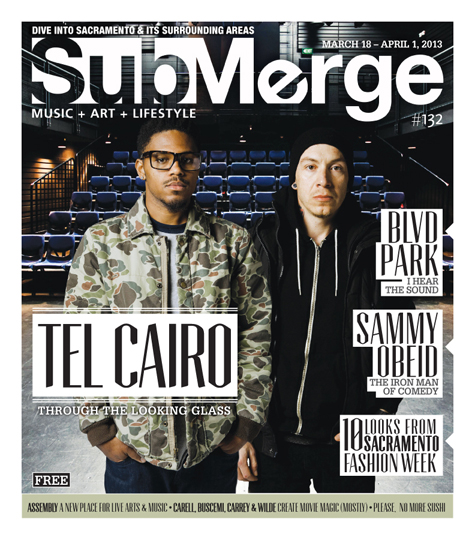
Tel Cairo will celebrate the release of Voice of Reason at Midtown BarFly, 1119 21st Street in Sacramento, on April 4, 2013. This will be perhaps your only chance to see 7evin and Cameron Others share the stage with all of the vocalists who appeared on the album. For more info on the show, go to https://www.facebook.com/telcairo, or hop over to Midtown BarFly’s Facebook page, https://www.facebook.com/MidtownBarFly.

4 Questions with Mic Jordan, Mahtie Bush, Task1ne and Juliana Lydell!
How was it to work with 7evin and Cameron on your track?
Mic Jordan: They played me a skeletal version of the song they wanted me on and set me loose with no real guidelines. I definitely had input into its final outcome, but I also felt like, “OK, everybody here knows what they’re doing, they trust me do my thing lyrically, so I trust them to do their thing sonically.”
Juliana Lydell: They’re really open-minded, supportive, and enthusiastic. Creating with them is a lot of fun.
Can you tell me about the process, e.g. did they have the song done and let you do vocals over it, or was it more of a collaborative process where you aided in the musical composition?
Task1ne: They trusted my expertise and let me just record the track like how I usually do it with no problems. It was a blast. I fell in love with the track instantly. I’m a fan of all types of music, so it was great to get to experiment on something different.
Mahtie Bush: They built the track right on the spot, and as they did that I was writing to the beat. It just happened; we were on the same page. The vibe was ill.
What makes Tel Cairo vital to the local scene?
Mic Jordan: The fact that they are bridging the (artificially separated) electronic, alternative and hip-hop communities. Ultimately, what sets Tel Cairo apart is the fact that their music defies easy categorization while somehow sounding authentic no matter what territory it’s venturing into.
Juliana Lydell: How excited they are, how much they believe in community, and what a team effort they make out of the act of creation. They think big. It’s contagious.
How long until Tel Cairo achieves world domination?
Mic Jordan: Who’s to say they haven’t already?
Task1ne: A better question is, which one is Pinky and which one is the Brain? Inquiring minds would like to know.
Terra Lopez of Sister Crayon will be hosting all-ages live music nights at Broadacre Coffee (1014 10th Street) starting on Friday, Jan. 27, 2012. “I’m looking forward to it, and I think this city needs more all-ages venues,” Lopez recently told Submerge in an e-mail. “I want to host my favorite local and non-local acts in an intimate setting where the bands play a different set than they normally would, say at a bigger and louder venue.” She also noted that the shows will always be cheap, never more than $5. The Jan. 27 bill features Exquisite Corps, Garrett Pierce and a special DJ set from Lopez and Sister Crayon band mate Dani Fernandez. Doors open at 8 p.m. Keep an eye out at Facebook.com/broadacrecoffee for future shows and events.
[Editor’s note: We here at Submerge were devastated to hear of Daniel’s passing on April 8, 2017. His impact on Sacramento’s music and art communities will never be forgotten. Rest easy, old friend.]
The P and 21st block is a sleepy pocket in Midtown. Tucked away from the white noise of the freeways, littered with parking lots and office buildings and a tattoo parlor, it’s low-profile–unless it happens to be a dance night at Press Club or The Townhouse.
Both clubs are infamous alternatives to the posh world of dress codes and bottle service. At Townhouse, or Toho as some call it, the beer’s cheap, the drinks are stiff, the tagged-up bathrooms are claustrophobic and the entire interior is low-lit to obscure seedy behavior. It’s the only spot in town suitable for a dubstep and bass night called Grimey. Being coined by a local DJ who goes by Whores is just another notch in its anti-glamour esteem.
On his birth certificate, Whores is Daniel Osterhoff. He’s Dan to those who knew him before he was Whores. We met at his apartment on the north side of Midtown a few hours prior to Grimey. He does not live in a high-rise loft or a gutted warehouse that doubles as a skate park. He lives like the rest of us, in a modest complex with carpeted floors and enough space to stretch. Two fellow DJs, one of which was Jubilee just flown in from Miami, and Grimey resident photographer Eric Two Percent were hanging out. The walls were like those you’d find at any graf-writer/graphic designer’s abode; dozens of pieces from abstract to lowbrow with the exception being a giant rusted-red W mounted on the wall.
“Russell Solomon of Tower told me the letters were lying around on the roof of Tower Cafe,” Whores said. “So one night I climbed up there and took the W.”
While grabbing me a Red Bull from the fridge he apologized for the hair on the kitchen floor. A stylist friend that was hanging out had sharpened Whores’ close-cut before my arrival.
We stepped outside for a cigarette and chopped it up. It was not long before James Blake’s controversial quotes to the Boston Phoenix that caused a stir in dubstep were discussed. An uber-popular British electro-soul and dubstep artist, Blake railed the genre’s burgeoning “frat-boy market,” which is being labeled “bro-step.” His rant was widely publicized for statements like, “It’s a million miles away from where dubstep started,” and “It’s been influenced so much by electro and rave, into who can make the dirtiest, filthiest bass sound, almost like a pissing competition, and that’s not really necessary. And I just think that largely that is not going to appeal to women.” Periodically throughout the night, Whores and his fellow DJs coolly reminded me that it’s neither their taste nor in step with the identity of Grimey.
The success of the night is owed to the attention to taste, which can be misperceived as snobbery, but should not be construed as such. Even when resident DJ Jay Two approached Whores with the idea of a dubstep night, Whores was interested but hesitant due to a feeling that dubstep had reached its high water mark.
An attendee of Grimey is not given the opportunity to gripe “not this damn song again,” because its resident DJs (Whores, Jay Two and Crescendo) are intent on remaining ahead of the curve by playing records acquired on advance or playing the newest tracks they think need to be heard. It’s a dedication to the cutting edge that is scarce in the local clubs that rely on Top 40 or are just held down by stubborn old dogs disinterested in new tricks.

“I just hold steady with playing what I think people would like,” Whores said. “I’ve attended a lot of different dance nights everywhere from New York to Los Angeles, Seattle, Portland, San Francisco and Oakland. From the most underground to the most mainstream clubs, and I’ve taken little elements from each. But once you get the word out there, the word kind of does it itself.”
Much like fellow local veteran DJ, Shaun Slaughter, Whores is well traveled. He started DJing in 1997 as part of 916 Junglist before moving away in 2000 to Portland. Each move, he connected with different crews in Portland and Seattle before moving back to Sacramento in 2005. “Most people don’t know that about me,” he said. “They just think I came on the scene or think I’m from Portland, but I’m born and raised in Northern California.”
I reconvened with Whores outside of the Townhouse around 9:30 p.m. He was talking with Matt B of Bass Science, who had arrived in a rental from Tahoe. Whores was quick to share his knowledge on Bass Science, practically orating a short bio. “He started the whole glitch hop scene basically,” Whores said. “When Glitch Mob was starting out and Lazer Sword, he was right there. This guy’s got quite a big history in the newer EDM alternative craze.”
All professions have a language and despite my familiarity with Grimey and its music, talking to the actual artists involved meant brief interruptions to ask if they were saying “IDM” (intelligent dance music) funny, only to learn that EDM translates to electronic dance music–the domain in which the sub-genres operate. The confusion then sparked the two DJs into weighing the blurring sciences between EDM and IDM. “Some of it is [IDM] though nowadays,” Whores said. “Some of the juke stuff. Machinedrum’s new album.”
“The Lazer Sword,” Matt B added. “It’s intelligent footwork basically.”
“EDM is basically a very blanketed term,” Whores continued. “Nowadays everybody plays a little bit of everything because people’s attention spans are about this small [makes his index and thumb nearly touch]. So if you play one genre of music, you’re pretty much pigeonholing yourself and boring the shit out of the crowd.”
Whores stepped into the booth at 10 p.m. The bar was filling out and overflowing onto the dance floor with more than just gangly dudes having acid flashbacks from the Jungle club days. Whether it’s the Whores hype, the distancing from “bro-step” and “filthy bass” or just a misnomer, Grimey is never short on female attendees. By 10:30 p.m. the dance floor was gaining steam with a few girls entertaining each other, but come 11 p.m. to 2 a.m. the floor was a grinding, thrusting hot box of sweaty bodies–sweet, sweet uninhibited decadence.
Whores neither bores the crowd nor himself when he DJs. He keeps a folder of over 10,000 tracks on his computer at all times and does not practice a strict set. “It’s a lot more fun freestyling sets,” he said. “Sometimes when I record the sets and go back to listen to them, it’s like, ‘Man, that mix really worked.’ Others it really didn’t work, but what it comes down to is if you’re a professional, you can treat it like a jazz musician and play out of it. It’s all what you do with an error. Some DJs don’t know how to bounce back, they flop or they panic and that shows. That’s the difference between me and some DJ who took it up two years ago.”
Back outside we resumed our interview session in hopes of a quieter haven, but Grimey is the dance night with just as many attendees milling about the roped-off outdoor smoking section and back parking lot as there will be jammed into the dank of The Toho.
Whores clearly enjoys the popularity of Grimey, but he lamented that its success led to the compromise of his HUMP night on Wednesdays opposite Grimey. Originally called Warpaint Wednesdays with Terra Lopez, Whores came on to assist with the DJing and teach her techniques. Once Lopez began Sister Crayon, she forked over the night to Whores who renamed it HUMP.
“It used to be a popular night,” he said. “When Grimey came around it took the spotlight. I’ve been bringing around a lot of relative and instrumental electronic artists and musicians to try to bring it back.”
It was none of my business, but Whores willingly broke down the financial losses he’s incurred in the past two months that’s led to HUMP’s demise. DJs that are not conveniently touring the West Coast are flown into Sacramento and given hotel accommodations on Whores’ dollar. If no one shows, it means he bites the bullet.
San Francisco electronic artist EPROM and Frite Nite’s Salva, two rising beacons in the West Coast, are booked for HUMP at the Press Club this week. After that it’s the anniversary party with locals only in November, including Dusty Brown’s Little Foxes project, which is quite possibly also HUMP’s night of eulogy.
With Fuck Fridays dissolved, the Toho was in need of a new Friday night event, and Shaun Slaughter was back on the market for work. Rather than compete for the local crown, Whores and Slaughter teamed up to create Heater, an exclusive once-a-month party that combines glitter and gutter. “It’s more like HUMP with an open format,” Whores said. “We can play anything from house to electro to Baltimore to indie to dubstep and bass n’ breaks, whatever. It’s just straight party.”
The party debuted last month with the two DJs performing separately, and then trading off tracks for the last hour. “There’s always been an odd tension between us, but we’ve always been super-friendly with each other. I’ve been super-supportive of his nights and he’s been super-supportive of mine. The odd tension was because it’s a small town and he’s held the crown for quite a while. I think we’d really benefit if we did more stuff together, which is why we’re only doing it as a monthly.”
Our vibrations are in good hands with the Grimey residents. It’s a rare event where making requests is the greatest faux pas. “I don’t think it’s common knowledge that people know it’s rude,” he said. “Believe it or not, I have one job and one job only and that’s keep the vibe going. As soon as I stop to talk to someone and they go into detail about what they want to hear and why they want to hear it, all of a sudden they take me out of the groove I’m in, which takes away from the vibe. The next mix I do will be less involved and the crowd will notice, believe it or not. They won’t necessarily think about it like, ‘That mix sucked,’ but just have a moment to consider going out for a smoke.” Put your trust in Whores, kids.
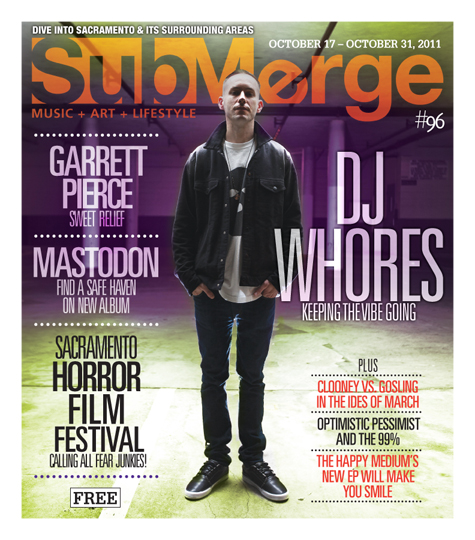
Grimey gets down at the Townhouse every other Tuesday night at 9 p.m. ($10 cover). DJ Whores and Shaun Slaughter’s Heater happens one Friday per month, also at the Townhouse. It’s free to get in before 10 p.m. with an RSVP. You can also catch DJ Whores at the Golden Bear on Saturday nights.
Sister Crayon Steps It Up Further on Debut LP
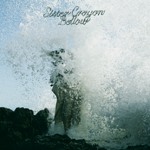 It was a gray and windy afternoon on the beaches of Malibu. A tidal wave warning was in effect, but there local band Sister Crayon stood, fully-clothed, sharp shoreline rock at their ankles, as photographer Eliot Lee Hazel barked orders to capture the frozen chaos of crashing white caps for the band’s debut album art.
It was a gray and windy afternoon on the beaches of Malibu. A tidal wave warning was in effect, but there local band Sister Crayon stood, fully-clothed, sharp shoreline rock at their ankles, as photographer Eliot Lee Hazel barked orders to capture the frozen chaos of crashing white caps for the band’s debut album art.
Lead singer Terra Lopez slipped during one shot, cutting her leg, but Hazel ran his shoot like a drill sergeant. “He just said, ‘Get up. Don’t smile. Don’t look at me,’” Lopez said. “Well, he’s a sweetheart, nice guy, you can sit down and talk to him, but when he’s taking photos he is so intense.”
As absurd as it feels to the members of Sister Crayon, Lopez and drummer Nicholas Suhr spoke of the shoot as one of their most memorable music experiences–even though it had little to do with music. Along with Hazel’s artwork, the band has a high-def music video done by celebrity photographer Robert Ascroft. Browsing both photographers’ websites, perusing the tastefully gratuitous images of Devendra Banhart, Usher, Mariah Carey, Edward Sharpe and Brad Pitt, Sister Crayon will be the first to tell you how privileged, yet out of place they feel. Are these the last remaining minor moments of Sister Crayon before they receive Coachella bookings and Japan tour offers?
In the next few weeks, the band is playing humbler venues like Townhouse for the Sacramento Electronic Music Festival and Luigi’s Fungarden for the Bellow album release party. So our indie darlings have yet to grow too big for our sleepy city. Lopez looks like a siren Viking vixen in the video for “(In) Reverse,” but when I met with her and Suhr at Mondo Bizarro (formerly Butch & Nellie’s) for an interview, she was back in her Midtown garb, a second-hand green army jacket and jeans–the Lindsay Weir of Freaks and Geeks look. She’s still the same shy songwriter, fronting a gloomy pop act that seeks inspiration in the lonesome despair of poets like Jean Genet and Fernando Pessoa.
The Bellow sessions scattered across the span of a year and a half. The newly realized lineup of Sister Crayon crammed in 18-hour shifts at The Hangar with engineer Scott McShane, who described the process as “tense” and a “guerilla recording style.” McShane produced the first Sister Crayon EP, Enter Into Holy (Or)ders, and the band never entertained the thought of working with anyone else. “Recording already is a really intimate thing. We bond so well with him. He gets what we’re trying to do, even before we understand it,” Lopez said.
“He’s able to throw out ideas that’s not in an insulting way. It’s just full-on experimenting and you know that it’s for the best. He pushes us to succeed,” Suhr added.
The tension came from the hourglass pressure of paying for studio time and the unfamiliarity of having a new drummer join two weeks prior, writing his parts on the fly. Suhr was not a complete stranger, knowing Lopez from her stint in The Evening Episode, but he and Lopez talked of the anxieties surrounding a debut full length. “We were zombies. We’d spend 18 hours in the studio and you can hear it in the record,” she said.
Originally, Bellows was intended to be a five-song EP, written by Lopez and synth-keyboardist Dani Fernandez, with “I’m Still the Same Person” being the only pre-released song to make the album. But once the band wrapped recording those five songs, creativity was running high and five more songs were written collectively. “Scott kept telling us there was a lot of tension on the record,” Suhr said. “If you know what was going on at the time it makes sense. There was a lot of time spent coming to an agreement on things, but whenever we’re writing together there’s no awkwardness. It was easy to go into the next five songs with an open mindset.”
Indeed, the settling in is brazen and culminates with a spacious piano ballad called “Ixchel, The Lady Rainbow,” in which Lopez’s visceral croon soars over a piece written by former member Genaro Ulloa. “Ixchel” was the last song the band recorded, a one-take recording done well past the midnight hour. “We did it live tracking,” Lopez said. “He was in the other room and I was in the main room singing. We could see each other through a little window, but that was it. It was the first take and it was incredible. I know it sounds corny, but there were tears in everyone’s eyes. We were all exhausted. Even Scott had tears in his eyes.”
Suhr added, “It’s one of those songs. Every other song on the record we did multiple takes because we felt we could do better. At the end of that song, everyone was just like what the fuck. It’s one of those songs where if it didn’t sound like that, with the imperfections left in, it wouldn’t have worked.”
The gloomy pop instrumentation informed by the troubled words of dead poets is an appropriate setting for an album titled Bellow, but Suhr said a lot of the mood is owed to McShane’s guidance. “I heard the five songs written before I joined, but the mood had changed through Scott’s ears.” Lopez said his touch is most prevalent on “Here We Never Die and “(In) Reverse” as he took the band’s ideas and focused them into a cohesive sound.
In addition to McShane, the Sister Crayon sound, most notably the lyrics, is in homage to the writings of Fernando Pessoa, a 20th Century poet and literary critic. Lopez only admitted her obsession with Pessoa’s work. She has a Pessoa tattoo and her Pug’s name is Ophelia, after Pessoa’s secret crush to whom he never confessed his love. “It’s the despair,” she said. “It sounds dramatic, but he was such a lonely individual. He was very mysterious and obviously people are drawn to that.
“I think that is a huge part of Bellow. ‘Here We Never Die’ is my talking to a lover in that way. The despair and sadness that he wrote is so sad that I can’t even finish one of his books. I have to read a sentence a day sometimes because it’s so much. It just floors me. I have no option when it comes to his presence in my music.”
As intense as Sister Crayon is sonically and visually portrayed, Hazel’s insistency that the band stop smiling as the chilly Pacific waves capsized on their heads speaks of the band’s unbridled joy in its work. As arresting as “Ixchel, The Lady Rainbow” is, Bellow closes with “Souls of Gold,” a cheery campfire sing-a-long with a blasting brass section and woozy synths. “We’re always such a serious band and a lot of our songs are really dark,” Lopez said. “I do like that the album ends on a lighter note than what it could have been.”

See Sister Crayon live at their release party for their new album Bellows at Luigi’s Fungarden on Feb. 19.
Sea of Bees is a buzz with debut album
Just as I was getting ready to ring the bell labeled “Tape Op” on the door of Sacramento recording studio The Hangar, I heard a voice down the street call my name. “Adam!” I turned, and up rode Julie Ann Bee on a well-worn brown bicycle. We exchanged salutations and made our way inside the giant warehouse studio that was once a punk venue years ago. Bee treats me like a friend she’s known for years, a facet of her personality that makes her so easy to engage. I’m really excited for our interview.
Inside the engineer room, where Bee recorded and mixed her first EP appropriately titled Bee Eee Pee, a large mixing console and strange audio concoctions surround us as we sit down to begin. She informs me of the soul this particular room has. Besides being the place where her own journey began, this space was where Terra Lopez of Sister Crayon mixed parts of their record, and the bassist for Rilo Kiley, Jonathan Wilson, recorded a few tracks here himself. Bee hums me a line from a Rilo Kiley song titled “Silver Lining.” It’s a treat, and I’m lost in her voice for a second and stumble over my words when she asks me if I’ve heard of them.
Bee is the singer/songwriter of Sea of Bees, and she is a rare talent. Like a ship in a bottle, she has slowly built herself up inside with love and passion for everyone to see and hear. To watch her sing is almost as enjoyable as hearing her, as the harrowing words flutter from her tiny mouth and her hands strike the strings of her acoustic guitar, brown hair falling over her face. YouTube videos show Bee playing songs like “Skinnybones” and “Gnomes” to rooms full of people who stare at her mesmerized as if gazing into a supernova.
It was at age 15 that she first knew that she wanted her own voice, a different voice.
“But I didn’t know how to go about it,” says Bee.
At that time, Bee was in a youth group at her church where a woman she admired was singing and playing guitar. Bee was “in love” with her voice, and like all great artists have done, she emulated the voice she admired most.
“I just blended with her voice and knew how to do it, compressed it and worked on it.”
Eventually she wanted to make this voice her own, and over time she crafted it to sound the way that it does–natural. Not a word feels forced when you hear Bee sing and even when she cranes her neck and reaches for notes, they wail as if being squeezed from the depth of her very being.
It was her voice that, like a siren’s song, lured in the man who would help guide Bee along her blossoming career.
John Baccigaluppi, publisher of Tape Op magazine and owner of The Hangar, was walking down the hallway of his studio one day when he heard Bee’s voice for the first time. Bee was passing the time in one of the rooms while her current band at the time, Find Me Fighting Them, was recording in the studio. She grabbed a guitar and was recording some demos on Garage Band. Baccigaluppi popped his head in after thinking to himself, “whoever is singing has a nice voice.” He gave her his card and when they talked later, it became clear pretty quickly that Bee needed to come into the studio. She had no real demo and Baccigaluppi wanted to help.
“I said come over and we put her in this room and I kind of showed her how to work ProTools and then left for the day,” recalls Baccigaluppi.
Bee, brand new to ProTools and left to her own devices in the studio control room, went to work. At the end of the day, she had a nearly complete five-song EP that would become Bee Eee Pee.
“I was under the impression that she would come in here and just bang out something,” says Baccigaluppi. “But I would come back and there would be all these overdubs. I was like, ‘Well I guess you figured out how to do that!’”
Having never really recorded a record herself, Bee took full advantage of the opportunity she was granted.
“I didn’t know how many days people spent on recordings. I was just like, ‘Gotta get it done,’” she says.
Maybe it was that exact attitude, that excitement to record, that kept Bee and Baccigaluppi working together. When Bee’s EP was complete, they decided to continue recording, tackling two songs in full production together (“Gnomes” and “Willis”) to see if they “got along together and wanted to go further.”
“We decided to do a whole record,” remembers Baccigaluppi.
With Songs for the Ravens, Bee and Baccigaluppi worked at a slower pace, only doing a few tracks at a time. The recording experience was centered on having fun making a record and exploring any ideas that came into the picture along the way. Bee would record an idea on Garage Band and show it to Baccigaluppi so he could get an idea. From there, they slowly pieced together the songs one track at a time, adding bass here or drums there. Bee herself played 80 percent of the instruments on the album, some of which she had never played before.
“She’s super intuitive as a musician. There’s a lot of stuff on this record with instruments that she played in one or two takes that she’d never seen prior to that,” says Baccigaluppi.
Very limited editing was required for the record, too, and a lot of what you hear on Songs for the Ravens are raw, uncut tracks. Half the tracks on the record, including “Blind,” the masterfully crafted outro song, were live takes, recorded with the other musicians. That says a lot about this record and the musicianship that was involved. Standout players include the tasteful drum set playing of James Neil, who, at times, nailed tracks immediately with very little time to record or to rehearse. It seems as though everybody involved in the creation of this record connected seamlessly with Bee and was able to interpret her ideas perfectly.
“The songs that were in my head, I had a vision of what I wanted them to be. They somehow came out exactly how I wanted,” says Bee with gratitude in her voice.
Another interesting note is the appearance of Wes Steed of Hearts and Horses, who offered his meticulously placed drum programming on songs like “Won’t Be Long” and my personal favorite, “Willis.” Steed was given very rough mixes of the songs to allot as much room as possible for him to navigate the drum tracks. Steed’s tracks were imported toward the end of finalizing the songs, and they would, without fail, fit perfectly into the mix.
The business side of putting out the record was always tucked in the back of both Bee and Baccigaluppi’s minds, but it didn’t need to be dealt with until it was finished. With that moment now upon them, the first thing they did was send it out to a few people that were close in both of their circles. Michael Leahy, who runs Crossbill Records in Davis, was one of the first to respond to Songs for the Ravens. Baccigaluppi sent him a copy immediately after mastering and he replied quickly, saying that what they had created was pretty awesome and to shop it around to lots of different labels. So they did, but to no avail.
“We spent a fair amount of time looking for labels and had some interest from some larger labels, and in the end no one was willing to move fast enough,” explains Baccigaluppi.
In the end, they went where open arms would receive them and inevitably ended up going with Crossbill. This turned out to be a great decision for Bee and was mutually beneficial, as Leahy scored a distribution deal through Burnside Distribution in Portland, Ore., with help from the strength of Songs for the Ravens.
“They’ve been really working it. Every week there’s more good news from Burnside,” says Baccigaluppi.
On top of Leahy standing behind the record and pushing it aggressively, he had a couple more friends up in Oregon that he wanted to introduce Bee to. Riot Act Media, a boutique publicity firm in Portland, picked up on Songs for the Ravens and offered their support for Bee.
“Riot Act’s Joan Hiller and Nathan Walker, they’re good people. It’s like family,” says Bee.
The pace of Bee’s success is steadily picking up with the anticipated release of Songs for the Ravens. And although she’s no stranger to performing, she’s just now starting to warm up to her audience–just in time for a 12-date tour that will land her in San Francisco, Los Angeles and New York, to name a few.
“I’m learning to open my eyes and see [the audience]. I’m starting to understand that it’s not just about me and my music, it’s about them,” says Bee. “I want to bring more to the table.”
When I asked Bee if she had measured out any sort of success for herself, she brought up musician friends that she and Baccigaluppi have who are able to “pay their rent and buy a car” by playing music. Modest goals for someone so talented.
“How do they do it?” Bee pondered. “It’s a lot of work. But it’s what I want to do.”

A look at the Sacramento scene shake-up in 2009
It was a difficult year for the local musician as at least eight bands met their demise. Swansong shows were played, vans were crashed and relationships collapsed in bittersweet endings. The silver lining in the shambles of bands lost? As we transition into a new decade, we’ll be greeted by fresh and lovely new bands.
That’s how this thing works. Take last year’s demise of The Evening Episode. Had they not called it quits, Terra Lopez would not have gone on to create our beloved Sister Crayon and fill that indie-pop gap in our lives. For now, it’s the breakup that is fresh for these fallen bands. Only last month, Buildings Breeding unplugged from the scene, citing a lapse in dedication as its reason for departure. Vocalist and guitarist Chris Larsen said Buildings Breeding hit a rut after founding guitarist Evan Hart moved to Oakland.
“I can’t really pinpoint what it was that made the decision,” he said. “It seemed the better we’d get, the less people would care.”
Fresh off a May tour, the band experienced a transformation from its lo-fi roots into a polished songwriting style that would become its Kite Fire EP. A man down, the group brought in Kevin Dockter on guitar and Justin Titsworth on drums. “It made the band feel brand new; finally it felt like we had something,” he said. “Even our oldest songs were fresh again. It definitely gave us a second wind.”
Buildings Breeding booked an extensive tour for November to promote the EP, only to learn that three of its six members weren’t available to travel. The band attempted to have friends fill in as best it could, but Larsen said it was apparent from those reluctant moments the band was kaput. “Chris [Vogel] and I would speak every night,” Larsen said. “When we kept coming to the same decision, we knew we had to end it. We decided to honor what local shows we had and add two farewell shows.”
The farewell show happened so frequently this year it could have been considered a fad. Bright Light Fever played its final show at Harlow’s on Sept. 10. The group had a six-year run eulogized by a can of soda.
“We bought a six pack of Sunkist orange soda before we started pre-production on our first record,” Matt Ferro, Bright Light Fever’s guitarist, said. “We drank them all but one can and kept that can in our practice room as sort of a good luck charm for the whole time we were together. When we were loading up for our last show, we looked at it and—no joke—the expiration date was Sept. 10, 2009. Same day as our last show. Poured it out in the back parking lot of Harlow’s.”
It was to Bright Light Fever’s benefit they did not share the newly expired soda. The band’s lifespan was marred by unfortunate events the members wore like an honor badge sash. Within a month of its debut’s release in Oct. 2006 on Stolen Transmission (an offspring label of Island/Def Jam), Bright Light Fever lost its distribution. By July 2007, Bright Light Fever was dropped from Stolen Transmission. The group wrecked two vans in Wyoming on two separate tours. BLF self-recorded and self-released its second record, eventually putting it on the Internet for free download due to “months wasted on empty promises and overall snakery by outside parties.”
The band finally toured without losing money last November. Alas, its follow-up summer tour led to law enforcement issues in Arizona, hitting a deer in Omaha, eight of 12 shows paying nothing and its newest member quitting. “We all genuinely loved the band, so we did it for as long as we could keep our sanity,” Ferro said. “Honestly, all the bad luck inspired us to work harder at what we were doing.”
Punk band Blame Betty attempted to bear the brunt for four years. Lead singer Brooke Sobol said being in a band exposed her to a potential she never understood, but when your band is in a constant shuffle of members, the lack of dedication wanes the drive. The band burned through four drummers, four bassists and two lead guitarists. “The more we accomplished, the more I wanted to accomplish,” she said. “When the dust settled, we had a good, solid group for a long time.”
Blame Betty broke up in September. Sobol said she was exploring a business opportunity that monopolized her time. The stability of Blame Betty suffered. “I just couldn’t do both,” she said. “The pressure of being the front person got to be more than I wanted. I actually have stage fright. There’s a lot of pressure on the front person.” Sobol said she wants to be the girl standing next to the lead now—drinking a beer and playing her guitar like a crazy woman.
Buildings Breeding split without its inner-band relationship suffering. Larsen and drummer Melanie Glover are still together. “Being able to share music with my true love Melanie, it was at times difficult, but so incredible to see her grow as a musician,” Larsen said. This is the exception.
David Mohr found out the hard way when he split with Meg Larkin just before the summer, leaving Sacramento without its premiere dance duo, 20,000. “I tell people now not to be in a band with your significant other,” Mohr said. “People warned me. I should have taken their advice.”
When Mohr ended his six-year run with previous band Didley Squat, he said it felt like an actual breakup, the intimate kind; but losing his band and girlfriend in a breakup was a crushing blow to his psyche. To make matters worse, the laptop they used to make their music was Meg’s computer. Mohr tried to record on his old four-track, but found the process frustrating.
20,000 never had an official last show. The breakup happened amidst scheduled dates around Midtown, each of which drove the nail deeper into the coffin. Mohr remembers one show in particular at Luigi’s Fungarden. “I was dreading that show,” he said. “It was right after we broke up and the plan was to keep the band going. It was just too weird to get on stage with your ex-girlfriend and pretend to have a good time, pretend to be into the songs when really you’re done with it.”
So why is this happening? Mohr said he is concerned by an influx of negative energy. In Bright Light Fever’s bassist Don Suave, he astutely wrote in the band’s obituary, “it has been frustrating to see our fan base consistently waning while, from my point of view, the quality of our work has been consistently waxing. What I’m saying is, ‘It’s all your fault.'” Similarly, Larsen expressed a frustration with the abandonment that came with his band exploring hi-fi aesthetics.
“I think [the band] was let down by that fact because we were all extremely proud of the stuff we were creating together. Add the hopes of being signed to a new label and having them leaving you dead in the dirt, that is sure to shake any band up.”
Blame Betty spent two years convincing a club to let them play and brought 75 paying attendees out on a Thursday night, only to have the rest of the bill spot four people and split the door money. “[The club] didn’t return any of my calls to get another show booked there,” Sobol said. “But, the other band still does shows there.”
Let’s not forget the silver lining. With the dissolution of such great bands, an absence is left within the artist. As Ferro put it, “playing in a rock ‘n’ roll band makes you cool. Like smoking cigarettes. So right now, I’m lacking cool.”
He and his brother Evan immediately continued writing music under the moniker Roman Funeral. The duo hopes to record an album by the spring and tour in 2010. Larsen is doing a “solo-y thing,” while his ex- bandmates have taken to other local acts like bands with ex-The Matches members and playing with Chelsea Wolfe.
Mohr obtained a laptop and has released two free digital records as Favors. His new venture retains the 20,000 sound, but with a lot more heartbreak. He is currently practicing with Ben and Chris of Impotent Ninja, as well as Chris’s girlfriend, which made Mohr wary at first. “I definitely spoke to Chris about it, but I think they might be stronger than Meg and I,” he said. He hopes to do Favors shows by the summer.
Through all the bullshit, each band had no problem expressing its gratitude for the little moments shared among bandmates and fans. For Ferro of Bright Light Fever, it was traveling in a van across the country with brothers and close friends and taking a piss while your bandmates all meet Iggy Pop on a street in Texas. Larsen recalls the feeling after Buildings Breeding’s last show as he thought, “If this many people came to our shows all the time, I would never quit. I could just play Sacramento and Davis the rest of my life.” Sobol recently caught a show with her bandmates. They still flirt with the idea of reforming again, pending a lead singer shows up. Mohr is doing his best to remain friends with Larkin. As of this week, he hopes he can give his friends one last 20,000 record. The two finished, but never released, an album before the breakup. “Up until about a week ago, I didn’t want to get it out,” he said.
Sister Crayon to Release Its First Album as a Full Band
When Submerge spoke to Sister Crayon’s Terra Lopez, she and the band were mired in Southern California traffic. Currently on the road on the Broke Bitches tour along with fellow Sacramentans Agent Ribbons, Sister Crayon weren’t holed up “in a big van” like their tourmates. Instead, Lopez and company were situated in a cozy station wagon—a red Volvo.

Genaro in The Crawdad, a reliable yet cramped tour vehicle. She got us to where we needed to be
“It’s all over the place, actually,” Lopez says of Sister Crayon’s modest transportation. “But it’s been really good overall.”
Sister Crayon is still relatively young. The seeds for the band were first sown three years ago when Lopez’s prior band broke up and left her performing solo. She went on alone for about a year until she met Dani Fernandez, who plays drum machine and synthesizer for Sister Crayon. It was through this pairing that Sister Crayon’s sound began to take shape. Lopez says that when she was on her own, her music was “very quiet”—just Lopez and her guitar. Though she had used loop pedals and beat machines in her previous band, it wasn’t until she started working with Fernandez that Lopez began pooling all of her influences into her music. Lopez says that she and Fernandez “just clicked” and the two began incorporating hip-hop elements into Lopez’s not-quite-folksy singer/songwriter material.
“We both love hip-hop, but we like just all kinds of different music,” Lopez explains. “The first song we wrote together was ‘Lavender Liars'”¦ I played this weird organ and she just played beats over it, and it just stuck. We figured out that was what we wanted to do. When I met Dani, that’s when things changed. I was like, ‘I finally met someone who could help me out with the sounds I had.'”

Chelsea Wolfe and I at the Smell in L.A. This show was with VOICEs VOICEs
and had Keith Haring murals!
Even when Lopez was performing on her own, she recalls that she always felt as if her music would lend itself to a bigger sound.
“When I was playing by myself, I liked what I was doing, but I always heard more,” Lopez says. “I always wanted more.”
Sister Crayon’s sound became even fuller with the addition of keyboardist Genaro Ulloa-Juno. The band operated as a twosome for about a year until Ulloa-Juno entered into the mix. Lopez says that the multi-instrumentalist was an easy fit into the band’s dynamic.
“It came together really simply, actually,” she says. “I asked him over to my house one day to listen to some stuff and see if he could add any thing, and we just hit it off.”
The band grew even further only just recently. Nicholas Suhr hopped on board only a few months ago. Hailing from the Bay Area, Suhr is now Sister Crayon’s drummer, adding a visceral snap to the band’s ethereal electronic beats.

Dani at a mansion (literally) 5 houses down from Snoop Dogg. Crazy story how we ended up staying at a mansion but it was by far the best night on tour. Thank you Pomona, Calif.!
“It’s really awesome to have a fuller sound,” Lopez says.
Suhr’s drumming came at a crucial time for the band as they were preparing their first proper CD release. Lopez released a Sister Crayon album, Loneliness Is My Mother’s Gun, earlier in 2009 via Chicago indie label Juene Été Records; however, she says their upcoming effort will be more indicative of Sister Crayon’s current sound.
“That album is just my stuff; they’re bedroom recordings,” Lopez says of Loneliness”¦. “Dani’s on a couple of tracks on that as well. I never intended to put that out. I was just going to sell that for $5 at shows”¦but the label contacted me and they were like, ‘We really like what you’re doing. Can we put this out?’ And I was like, ‘Wow.’ They paid for it all, so I was like, ‘Sure.'”
On the other hand, Enter Into Holy (Or)ders, Sister Crayon’s upcoming release, features the entire band—including Suhr, who had only joined the group a “week or two” before they went into the studio.

Chelsea Wolfe, Nicholas Suhr and I passed out after the house party in Pomona, Calif. We were up until 5 a.m. with the most amazing new friends we met earlier that night.
“He had to learn and write all of his parts while we were recording,” Lopez says of Suhr’s kind of trial by fire. “It was really cool that he was able to do that, because we had all been playing those songs for months, and he had to learn everything in the studio.” Lopez called the recording sessions for the album “intense,” saying that the band was logging 14 – 18 hour days at The Hangar, where “¦Holy (Or)ders was recorded, produced by the band with help from Scott McChane, including “really long practices.”
The intensity with which “¦Holy (Or)ders was recorded is reflected in the music. Though Lopez says her lyrics and vocals are important to her, she says the album’s focus was more on the music.
“For me, for this album, I wanted the music to be the main focus because it was finally getting more intense, which is what I think we all wanted,” she explains.
Though her lyrics may have been more of an appetizer than “¦Holy (Or)ders‘s main course, Lopez believes the force of the band’s music has definitely rubbed off on her lyric writing. She says that her lyrics may have been more personal when Sister Crayon was a one-woman show; and though they still pull from her private life, her writing has become more aggressive. She says that the lyrics she wrote to the songs on “¦Holy (Or)ders revolve around the events of this past summer: including a relationship she’d entered into and a book she had been reading by controversial 20th century French writer Jean Genet. In fact, the title of the album is taken from a line in one of Genet’s books.
“He was one of the first French homosexual writers,” Lopez says. “His writing is really dirty and really aggressive. That kind of intrigued me.”
Performance-wise, Lopez is also no longer the quiet singer/songwriter with a guitar. She says that now that she has the power of a full band behind her, she’s had to become more assertive on stage.
“I sing a lot louder than I used to,” Lopez says through laughter.
Blessed with a stirring and soulful voice, a louder Lopez can only be considered a good thing. The band should be back home from the Broke Bitches Tour by the time this issue hits the streets. However, the band won’t be able to relax once they’re back in Sacramento. Lopez says Sister Crayon will quickly return to The Hangar to finish mixing “¦Holy (Or)ders so that it’s done by their CD release party on Aug. 21. Further on the horizon, Lopez says the band is hoping to have more of a nationwide tour, and in January, the band will perform in Spain, where their album will also see release.
Sister Crayon
Saturday, Feb. 7, 2009
Luigi’s Fun Garden
On a cold Saturday night, Sister Crayon kept me warm. Not with blankets or pea coats, but with hope for a better Sacramento music scene. Some say it’s dead and gone; that all the good bands are broken up and nothing new can replace them. Others remain optimistic—attending the shows that get ignored and filling the dance floors that are void of moving feet. What we all agree on is our love of good music and the desire to have it here in our great city. Sister Crayon’s recent performance at Luigi’s Fun Garden was a step in the right direction.
The crowd that gathered outside Luigi’s Fun Garden squeaked about on the wooden deck that hugs the outside of the impressive MARRS building on 20th and K. As Sister Crayon set up on the cobalt colored stage, they had a certain air about them. The four of them were positioned patiently behind their respective instruments, fondling them appropriately with an unbreakable focus.
Surrounded by keyboards and synthesizers, Genaro Ulloa was tucked neatly into the left corner, methodically turning knobs and wrestling cables that twisted and hooked like octopus tentacles. Dani Fernandez hovered over an MPC beat machine, picking at it like an impatient child at the dinner table, deciding what she liked and what needed changing. Leon Smith sat hunched over his drum set, a long gray scarf fastened neatly to his neck. After catching up with Terra Lopez, the high priestess of Sister Canyon, I learned that during the course of writing the record Loneliness Is My Mother’s Gun, a Beatles-inspired title no doubt, she’d been slowly compiling a full band, and tonight was their first performance together.
Fernandez played a straight-ahead 808 beat that concisely anchored their first song as an airy, backward guitar loop smeared across our eardrums; thick as paint. The music opened up to a bleeding chorus by Lopez. “It’s so easy to get distracted”¦“ she repeated over and over, her voice mimicking a sampler. The texture took precedence over a constantly changing song structure. The songs were very linear and built with each new layer, be it Smith’s minimal drum playing or Lopez’s use of the Kaos pad to echo and distort her voice, which was undeniably strong. Each ‘down tempo’ gem sucked the easily entranced audience deeper and deeper into Sister Crayon’s universe of other-worldly noises, samples and synth lines. The overall effect was a little reminiscent of Godspeed You Black Emperor, Coco Rosie and Björk, the latter two being a big influence on Terra. The sound was minimal drums with maximum vocals that glide over the carefully quieting sounds of Ulloa’s keyboard melodies.
The rabbit hole took us to the last song, a nine-minute masterpiece filled with nearly inaudible field recordings of strange voices, reverberated harmonica, dissident guitar and a tardy drum build by Smith. The last note faded and the cold night was forgotten by an eruption of fiery applause.















